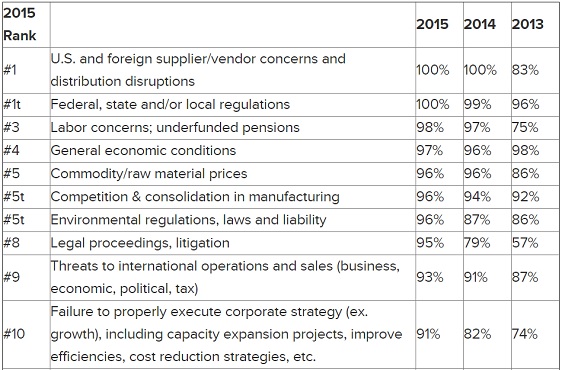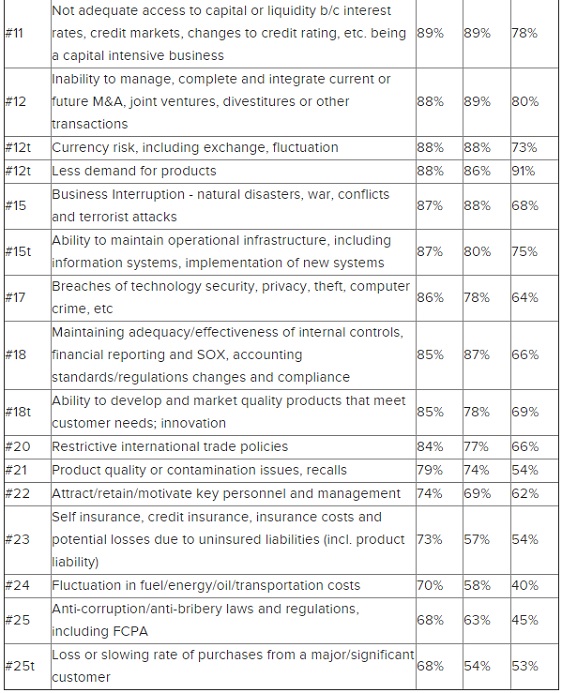Talent shortage grows as a key risk for the manufacturing industry
BDO study highlights risks for publicly traded U.S. Manufacturers as the industry struggles to attract and retain its workforce.
Latest Material Handling News
Registration open for Pack Expo International 2024 Walmart chooses Swisslog AS/RS and software for third milk processing facility NetLogistik partners with Vuzix subsidiary Moviynt to offer mobility solutions for warehouses Lucas Watson appointed CSO for Körber’s Parcel Logistics business in North America Hyster recognizes Dealers of Distinction for 2023 More NewsAlthough the manufacturing industry is in resurgence, concern over the industry’s talent shortage is escalating, according to the third annual BDO Manufacturing RiskFactor Report.
An analysis of risk factors listed in the most recent 10-K filings of the largest 100 publicly traded U.S. manufacturers reveals that 98% of manufacturers mentioned risks related to labor concerns, up from 97% in 2014, and 75% in 2013.
In a recent interview, Rick Schreiber, partner, manufacturing and distribution, BDO USA, said the continued economic resurgence means manufacturers are on an even economic footing. Yet he was surprised to find that, despite strong economic fundamentals like improved energy costs and employment figures at the national level, the manufacturing sector still shows cautious optimism.
“With increased stability, they are now focused on growth,” Schreiber said. “However, the challenge remains to fill their talent pipeline in order to pursue these expansion goals. Although unemployment is generally down, when you look specifically at the manufacturing world the labor gap just continues to grow.”
The challenge is compounded as talent on the factory floor and in the C-suite approaches retirement. It is estimated that by 2030, more than 20% of Americans are projected to be aged 65 and over, compared with 13% in 2010 and 9.8% in 1970, according to a recent study from the U.S. Census Bureau. Amid the retirement of leading innovators and strategists, 74% of manufacturers mentioned concerns around attracting, retaining and motivating key personnel and management, up from 69% in 2014 and 62% in 2013.
In an effort to combat the shortage, Schreiber said more clients are launching or expanding apprenticeship programs, partnering with community and technical colleges, or working on grassroots efforts to support science, technology, engineering and mathematics (STEM) education. From a recruiting standpoint, Schreiber said companies are taking a three-pronged approach. First, business audits can help identify areas of opportunity and growth and pinpoint where the skills gap is. Second is a comprehensive talent strategy that includes more significant investment in recruiting and onboarding. Lastly, companies are taking advantage of existing conditions like tax credits and workforce grants.
“The annual Manufacturing Day has been a great program for building awareness that manufacturing is still alive and can provide a good living,” Schreiber said. “A lot of companies are participating in that initiative, which has been highly successful.”
The report highlighted some of manufacturers’ other growing concerns. More than 90% of respondents cited risks related to the implementation of corporate strategy, up from 82% in 2014 and 74% in 2013. Continued product innovation is also a prominent risk, mentioned by 85% of manufacturers, up from 78% in 2014 and 69% in 2013.
A small number of concerns were cited less frequently this year, including those related to financial reporting. “Whether with regard to Sarbanes-Oxley or Dodd-Frank,” Schreiber said, “people feel more certainty thanks to improved technology and better data. They generally feel like they have that act together.”
The following chart highlights the top 25 risk factors cited by the 100 largest publicly traded U.S. manufacturing companies:


Source: BDO
*t indicates a tie in the risk factor ranking
Further findings in the 2015 BDO Manufacturing RiskFactor Report:
Extreme weather and natural disasters expose cracks in manufacturers’ supply chains. The most-cited risk for manufacturers continues to be supply chain concerns, including disruptions or issues from suppliers and vendors. For the second year in a row, the risk is mentioned by 100% of manufacturers.
- An ever-evolving regulatory landscape demands that manufacturers create reporting efficiencies. Risks related to federal, state or local regulations, including tax laws, are mentioned by 100%.
“We also saw increased mention around tightening environmental regulations, Schreiber said. “The Environmental Protection Agency (EPA) continues to pursue an aggressive agenda that impacts manufacturing quite a bit.”
As more manufacturers conduct business abroad, especially in high-risk markets, their mention of risks related to anti-corruption/anti-bribery laws and regulations is increasing. Sixty-eight percent of companies cite these risks, up from 63% in 2014 and 45% in 2013.
The dollar’s climb to 12-year highs in the first quarter of 2015 has stimulated U.S. production and domestic spending, but BDO warns manufacturers should be wary of an impending “chill.” It is possible that international business and exports could suffer as foreign buyers pull back. Threats to international operation and sales are mentioned by 93% of companies, up from 91% in 2014 and 87% in 2013.
- High-profile data breaches at large companies, including Home Depot and Sony Pictures, have catapulted risks related to IT infiltration to the top of manufacturers’ list of concerns. Eighty-six percent of manufacturers cite risks related to data security this year, up from 78% in 2014. Moreover, the protection of intellectual property and rising concerns around security are also likely contributing to the spike in manufacturers citing litigation risks (95%, up from 79% in 2014).

Article Topics
Latest in Materials Handling
Registration open for Pack Expo International 2024 Walmart chooses Swisslog AS/RS and software for third milk processing facility NetLogistik partners with Vuzix subsidiary Moviynt to offer mobility solutions for warehouses Materials Handling Robotics: The new world of heterogeneous robotic integration BSLBATT is looking for new distributors and resellers worldwide Lucas Watson appointed CSO for Körber’s Parcel Logistics business in North America Hyster recognizes Dealers of Distinction for 2023 More Materials HandlingAbout the Author
Subscribe to Materials Handling Magazine

Find out what the world's most innovative companies are doing to improve productivity in their plants and distribution centers.
Start your FREE subscription today.
April 2024 Modern Materials Handling

Latest Resources










